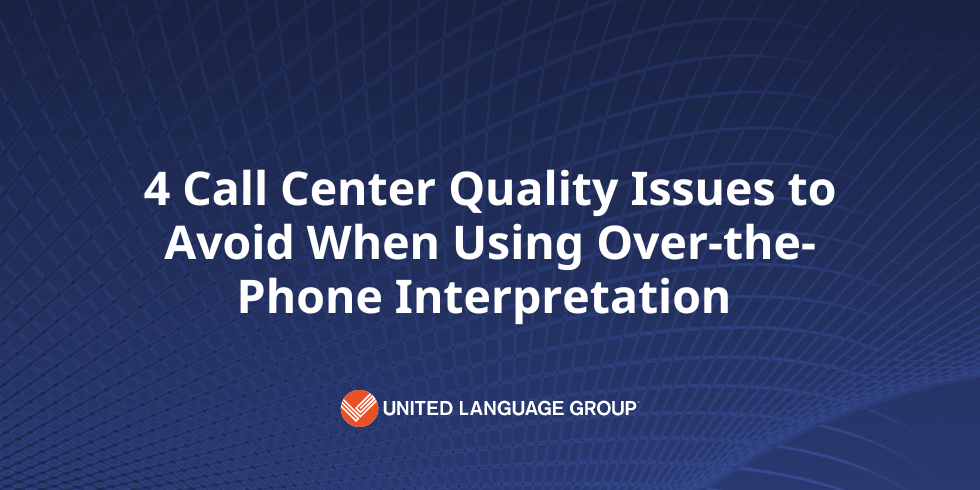Studies reveal that more than 25 million Americans require language assistance for daily activities. With the help of over-the-phone interpretation (OPI), you can connect your multilingual customers to interpreters in their native language and help your business provide these customers with the same level of support native English speakers enjoy.
It’s easy to connect your multilingual customers to industry-focused interpreters in the field, from healthcare and government agencies to technology and insurance companies—and every industry in between.
Telephone interpretation for multilingual customers should open, not close, doors for your call center operations. Implemented effectively, OPI has a host of benefits for both your business and its customers. However, it can create new problems if it’s implemented inefficiently, leading to higher dissatisfaction rates that send customers packing. To help you realize the full benefits, here are four call center issues to avoid when implementing OPI:
1. Access Issues
Customer support should be easy to access, no matter what language you speak. Yet, technical issues can get in the way. Muffled audio, choppy connections, and dropped calls frustrate customers and representatives alike.
For customers, this can mean calling back multiple times to get even simple issues resolved. From the rep’s point of view, the same quality issues lengthen resolution times and lower customer satisfaction rates. For multilingual call centers, all of these problems become amplified because of language barriers.
Below are some actions you can take to set customers and representatives up for success.
- Implement a user-friendly interface that customers can easily navigate.
- Invest in quality equipment so when customers do need live support, your call center provides a clear and reliable connection.
- Create specialized support teams so you can route callers to the appropriate service team without delay.
- Adopt a multi-channel approach by allowing customers to reach support through various channels such as phone, web, and mobile apps. This flexibility can distribute the call volume more evenly and improve overall efficiency.
2. Linguistic Quality Issues
High linguistic quality is critical for over-the-phone interpretation. This hinges on three key factors: interpreter skill and training, subject matter expertise, and cultural competency.
- Interpreter skill and training: Interpreters must be highly skilled and well-trained to handle the subtleties of real-time interpretation. Rigorous training programs help interpreters accurately and efficiently translate complex information without losing meaning.
- Subject matter expertise: Different industries have their own specific terminologies and jargon. Interpreters with subject matter expertise can navigate these complexities, providing accurate interpretations that are crucial for fields such as healthcare, technology, and finance.
- Cultural competency: Beyond language, understanding cultural context is essential. Interpreters who are culturally competent can bridge not only language gaps but also cultural differences, leading to more effective and respectful communication.
When these elements are lacking, the risk of misinterpretation increases, leading to misunderstandings and frustration. Making sure that your OPI solution includes interpreters who are well-trained, knowledgeable, and culturally aware will significantly improve the customer experience.
It’s also important to train staff regularly. Regular training sessions for both interpreters and call center staff can help maintain high performance levels and ensure everyone is up to date with the latest tools and techniques.
3. Outdated Technology
Call centers move fast, and OPI solutions have to keep pace. Outdated technology causes delays and call quality issues, and these issues are magnified for multilingual callers.
When multilingual customers wait on the line to be connected with an interpreter, the customer experience suffers. This decreases a call center’s call volume capacity and leads to longer average handling times, and it decreases customer satisfaction.
By leveraging the appropriate technology, your call center can make it easier for multilingual customers to get the help they need efficiently. Here are two ways to streamline the process of connecting callers with interpreters:
- Implement OPI solutions on mobile and web so getting in touch is as easy as a few clicks from anywhere in the world.
- Connect customers with an interpreter in their language from the beginning. Rather than re-routing multilingual customers from an English-speaking representative to the appropriate interpreter, call centers can leverage the technology of automated call menus to get multinational callers the support they need the first time around.
- Invest in scalable technology: Implement technology solutions that can grow with your business. Scalable platforms help accommodate increasing call volumes without compromising on service quality.
4. Lack of Quality Assurance
Another priority for call centers is quality assurance: monitoring overall metrics and individual calls to make sure that each call is being handled in the most appropriate way.
When callers receive misinformation from a representative or are unable to resolve their issue during a first call, they may begin to lose faith in a company’s support services. Without a quality assurance process, customers will grow impatient and call times will increase. Over time, a company’s reputation and profitability can suffer.
Regular quality assurance checks help improve the user experience by identifying and addressing issues promptly. This boosts customer satisfaction and enhances overall call center performance.
Stay on top of your call center’s quality assurance by keeping tabs on a few key metrics:
- Average speed of answering (ASA)
- Average handling time (AHT)
- First-call resolution (FCR)
- Hold times
- Call volume
- Customer satisfaction score (CSAT)
Finding Your Ideal Language Solutions Partner
Finding your optimal language solutions partner can help you develop a plan that will allow you to efficiently and effectively offer OPI services to your customers. Choose a language solution partner that prioritizes technical support, quality assurance, efficiency, and low-cost/high-value implementation.
We can help you get your call center off the ground. Our team can connect your callers with skilled interpreters in a matter of seconds. With 24/7/365 assistance in over 250 languages, your callers can be sure they’ll get the help they’re looking for the first time around
To learn more, check out our case study detailing how we helped the largest welfare provider in the U.S. with OPI services.


